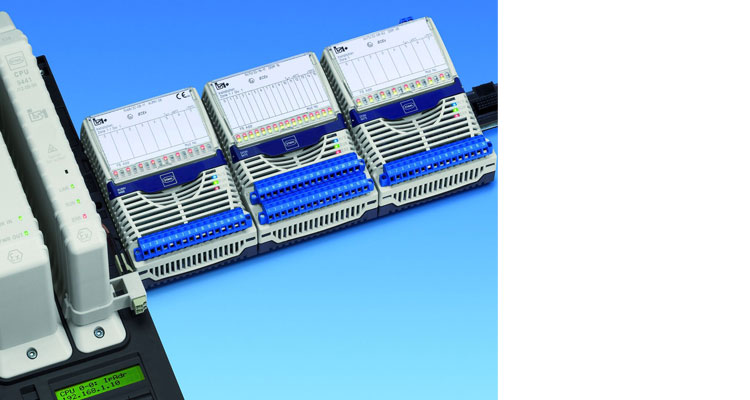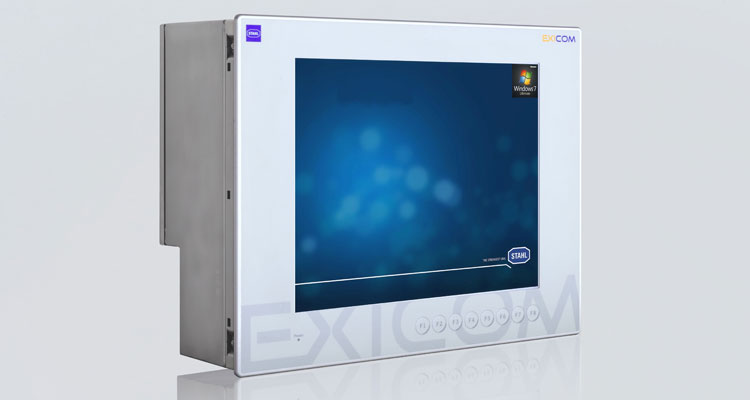Light and light energy can ignite explosive atmospheres, as the Physikalisch-Technische Bundesanstalt (PTB – National Metrology Institute of Germany) established in fundamental investigations during the 1990s. IEC 60078-28, which standardises optical explosion protection, has existed since 2006 (the second version has existed since 2015). Time and again, users and operators of process systems are confronted the same situation: Gas and dust hazardous areas are found in many applications and, at the same time, optical equipment from LED light fittings to fibre optics are present in large numbers. This article will provide a brief overview of the requirements and current technology in optical explosion protection.
Optical components in process systems
Process systems with hazardous areas in which no optical components may be used at all, are a rare exception to the rule. Light fittings, lasers, LEDs and similar components are required in most systems for communication, monitoring and measurement purposes. The progress of digitalisation is increasingly bringing Ethernet networking into the field, and therefore into hazardous areas as well. When bridging large distances in extended systems, in particular, and due to their excellent immunity, fibre optics are becoming an ever more popular choice for network technology. Depending on the optical fibre used, distances of 2 to 30 kilometres can be covered.
Light: An ignition hazard
It is easy to see why optical radiation poses an ignition hazard – simply use a magnifying glass to concentrate some sunlight onto straw, and see how quickly it starts to burn. When the energy is focused on a small area, it is magnified, meaning that it is many times stronger in the focal point than in the surrounding area. And what does an optical conductor do? It focuses light down to a very small point. PTB report W-67 on "Ignition of explosive vapour/air and gas/air mixtures due to continuous optical radiation" was published in 1996 by M. M. Welzel. In August 2006, IEC 60079-28 "Explosive atmospheres - Part 28: Protection of equipment and transmission systems using optical radiation" was published. It was implemented in Europe in October 2007. Since April 2016, the second edition has been available; it contains a number of additions and clarifications. In principle, this standard discusses four potential ignition mechanisms:
- Optical radiation causes particles to heat up – they can, under certain conditions, attain a surface temperature that could ignite an explosive atmosphere
- Thermal ignition of a gas volume because the optical wavelength matches an absorption band of the gas (a kind of resonance effect)
- Photochemical ignition due to photochemical dissociation of oxygen molecules by radiation in the ultraviolet range
- Direct laser-induced breakdown of a gas at the focal point of a strong beam, producing plasma or a shock wave, both potentially acting as an ignition source
The first potential mechanism – ignition caused by an excessive surface temperature – is the most relevant in practice. Installations can be protected in three ways according to the standard:
- Protected optical radiation "op pr"
- Optical systems with locking devices "op sh" (shut down)
- Inherently safe optical radiation "op is"
Unlike electrical signals, light is not limited in terms of its location. As a result, even a light source outside or near the hazardous area can shine into this area and cause an explosion. This must be taken into account during project engineering and risk assessment.
The second edition of the standard, in particular, explicitly refers to the fact that not every ray of light or LED will immediately become a hazardous source of ignition. A range of radiation sources are explicitly exempt:
- LEDs with divergent radiation that are not designed in a matrix arrangement or with laser technology and that are used to display a device status or as backlighting for LCD displays
- Light fittings with continuous divergent light sources (for all EPLs).
Light fittings with LED light sources (only exempt for "Gc" or "Dc" EPL).
However, all light fittings must comply with the general requirements for lighting equipment (e.g. minimum distances between the part generating light and bodies that can absorb light). - Optical radiation sources for Gb or Gc and Db or Dc applications that correspond to the Class 1 limiting values in IEC 60825-1 "Safety of laser products - Part 1: Equipment classification and requirements". In the case of these Class 1 lasers, however, an "eye to laser" distance, which is specified where applicable, is also relevant for explosion protection purposes.
Appendix C lists the procedure for assessing ignition hazards with respect to optical radiation.
Protected or locked
Protected optical radiation "op pr" is based on the idea of preventing radiation from escaping from its enclosure. FO cables must be designed so that they are robust enough for this type of protection or laid in such a way that they are protected from factors that could destroy them. Enclosures must be designed so that an explosion inside the enclosure cannot ignite the external atmosphere and so that no hazardous amount of light energy can reach the outside – as a result, they must not contain any inspection windows or similar features. This means that this method of protection largely corresponds to the "increased safety" and "flameproof enclosure" methods, which are familiar from electrical explosion protection. Another option is the "Ex p" pressurized enclosure type of protection. Specific cable entries and plug connectors are also required. Accordingly, any external connection in Zone 1 must meet all corresponding requirements from IEC 60079-0. Splice boxes, which are also available in a certified Zone 1 version, are an extremely suitable, reliable option for laying and distributing optical cables.
The second type of protection mentioned above, the "op sh" locking and shut down principle, relies on broken fibres being detected immediately and the optical radiation being switched off safely as soon as this occurs. The protective principle underlying this method of protection is based on a risk assessment. On this topic, users will be reminded of the "functional safety" set of standards (IEC 61508 and IEC 61511). IEC 60079-28 also makes explicit reference to these standards. Due to the extremely strict requirements for software and hardware, there are only a few products for this application on the market.
Optically intrinsically safe
The "op is" principle of inherently safe optical radiation is very similar to the "Ex i" electrical intrinsic safety concept. It is based on the idea of limiting the optical energy in a system – for example in a fibre-optic cable, under normal operating conditions and under certain fault conditions. This limits the permissible optical radiated power for use in hazardous areas in Zone 1 and explosion group IIB in temperature class T4 to a maximum of 35 mW (see table). Furthermore, additional requirements apply to pulsed radiation; these take the duration of the pulse into consideration. Appendix E of the second edition of IEC 60079-28 contains a flowchart to assess optical pulses.
Alternatively, the irradiance can also be determined as a quotient of the emitted optical power in mW and the irradiated area in mm². The "op is" type of protection is especially suited to Industrial Ethernet installations, since fibre optics offer the same advantages as those already known from electrical intrinsic safety. In particular, optically inherent safety offers outstanding flexibility; with this type of protection, FOs can be connected and disconnected in hazardous areas during operation. This means that installation and maintenance work can be performed in Zone 1 as easily as in non-hazardous systems. When installing "op is" fibre optics, it must specifically be noted that the cross sections of the optical cables used in the system must not be reduced. This could cause the focal point of a light beam to shrink, resulting in the available ignition energy increasing to impermissible levels. A principle similar to that found in intrinsically safe circuits applies: Multiple optical cables must be connected in such a way that no additional energy can enter the fibre optics.
One option that is easy to handle under these conditions is the use of Operating and Monitoring Systems, which can be connected and removed as required in mobile applications and at continuously changing operating locations without difficulty. They are also suitable for Remote I/O installations in which frequent modifications and extensions are made. The "op is" type of protection is also the simplest solution for those looking to continue using FOs into Zone 0. Although "op sh" and "op pr" can be combined as an alternative method of achieving this goal, this option requires significantly more expenditure and is less flexible to use.

Available technology
Special optical isolators are required for optically intrinsically safe networking. From a very early stage, products for the PROFIBUS DP were developed based on the principle of inherently safe optical radiation. R. STAHL launched the first solutions of this kind for the Remote I/O system IS1+ on the market at the end of the 1990s. Later versions of this product have even been designed to allow for optical rings to be installed in hazardous areas; running diagnostics and issuing alerts with these products, for instance in the event of a glass fibre breakage or for signal levels, is simple.
Solutions for Industrial Ethernet that can be implemented practically using media converters or switches are also available. For instance, with optically inherently safe Ethernet, the powerful Remote I/O solution IS1+, which many users have tried and tested to great success in Profibus DP environments, can be used in Zone 1 Until now, the Profibus DP has been one of a few fieldbuses that are capable of transmitting the volumes of data associated with a Remote I/O system in an acceptable time and that can be used to design even large system structures in a cost-effective manner. What's more, it is available for both copper and fibre optic cables in an explosion-protected version. Industrial Ethernet is opening up new possibilities for even faster, more efficient signal transmission. The IS1+ system communicates using a range of real-time Ethernet protocols such as PROFINET, EtherNet/P and Modbus TCP. In addition, OPC UA or classic FDT/DTM technology guarantees simple integration into diagnostics and asset management systems.
In conclusion
Digitalisation in systems within the process industry has been made possible thanks to Ethernet in the field. R. STAHL is also an active participant in working groups such as the APL Project, working on specification and device development for intrinsically safe Ethernet (Ethernet-APL). For years, however, fibre optics have been installed more and more frequently, since these enable large distances to be bridged and provide better immunity than copper cables. Whether users choose "op is" fibre optics or copper cables for Ethernet-APL with 2-WISE (2-Wire Intrinsically Safe Ethernet), they will always be able to choose from a comprehensive selection of potential options and devices, which can be used in a way that perfectly suits their installations.







![[Translate to Englisch:] [Translate to Englisch:]](/fileadmin/user_upload/mitarbeiter/01_DE/07_Blog/00_Allgemein/blog-explosionsschutz-rstahl-startseite-279x205.jpg)
![[Translate to Englisch:] [Translate to Englisch:]](/fileadmin/user_upload/mitarbeiter/01_DE/07_Blog/00_Allgemein/blog-explosionsschutz-rstahl-ueber-den-blog-279x205.jpg)
![[Translate to Englisch:] [Translate to Englisch:]](/fileadmin/user_upload/mitarbeiter/01_DE/07_Blog/00_Allgemein/blog-explosionsschutz-rstahl-autoren-279x205.jpg)
![[Translate to Englisch:] [Translate to Englisch:]](/fileadmin/user_upload/mitarbeiter/01_DE/07_Blog/00_Allgemein/blog-explosionsschutz-rstahl-newsletter-expert-mail-279x205.jpg)
And yes, Appendix C refers to the IEC60079-28 part "Ignition hazard assessment".